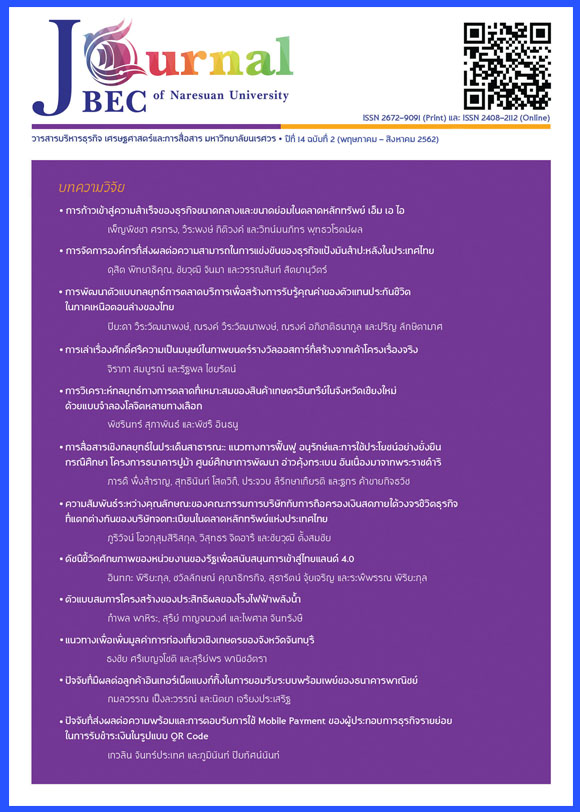Analysis of Optimal Marketing Strategies for Organic Agricultural Products in Chiang Mai Province with Multinomial Logit Model
Main Article Content
Abstract
The objective of this study was to analyze optimal marketing strategies for organic agricultural products according to marketing mix theory with multinomial logit model. Data were collected in the form of interviews with questionnaires from 2,500 consumers who bought the products divided into farm plants, processed and fresh organic agricultural products, herb products, and others by means of purposive random sampling of 25 districts in Chiang Mai province. It could be concluded that an increased probability of buying in the farm plant groups should focus on notification of product details and certified brand completely in product strategy. Similarly, the processed product should emphasize an organic agricultural product adequacy and attractiveness of the packaging. Moreover, the fresh and herb product groups should emphasize discounting, changing, distributing, adding, or testing of promotion strategies. It indicated that the marketing strategies influenced buying decision making to the different product groups. Hence, the determination of optimal marketing strategies was conducive to the competitive advantage.
Article Details
References
2. Kangpheng, S., Kunlong, S., and Kaew-In, D. (2016). Mixed methods: Paradigm of research for the 21st Century. Maha Sarakham: Apichart Printing.
3. Kramol, P. (2014). Factors Affecting Purchasing Behavior of Organic and Pesticide-Free Produce in Farmers’ Markets in Chiang Mai Province. Khon Kaen Agriculture Journal, 4(special), 227-234.
4. Kumar, V., Rahman, Z., Kazmi, A. A., and Goyal, P. (2012). Evolution of sustainability as marketing strategy: Beginning of new era. Procedia Social and Behavioral Sciences, 37(2012), 482-489.
5. Mahapatra, K. and Kant, S. (2005). Tropical deforestation: A multinomial logistic model and some country-specific policy prescriptions. Forest Policy and Economics, 7(2005), 1-24.
6. Ministry of Commerce. (2017). National strategy for organic agricultural development 2017-2021. Retrieved March 12, 2017, from https://www.greennet.or.th/sites/default/files/1704%20OA%20strategy.pdf
7. National Bureau of Agricultural Commodity and Food Standards. (2013). Strategic on safety standards for agricultural and food products. Retrieved November 10, 2018, from https://www.acfs.go.th/stategy04.php
8. Noisopha, S. (2015). Organic agriculture, an opportunity for Thailand to export and set foot in the world market. Journal of Thonburi University, 9(18), 83-91.
9. Notta, O. and Vlachvei, A. (2015). Changes in marketing strategies during recession. Procedia Economics and Finance, 24(2015), 485-490.
10. Office of the National Economic and Social Development Board. (2015). Gross provincial products. Retrieved March 28, 2016, from https://www.nesdb.go.th/Default.aspx?tabid=96
11. Ounchitti, S. (2016). Generic competitive strategy on the results achieved in the business of exporting organic products of enterprises in the global market. Independent study, M.B.A. (Marketing), Bangkok University, Bangkok.
12. Panplum, P. (2016). Factors affecting consumers’ willingness to pay for organic products in green markets and specialty health food chain stores in the Bangkok metropolis and vicinity. Modern Management Journal, 14(1), 169-178.
13. Panyakul, V. (2016). Thai organic situation 2016. Retrieved July 11, 2017, from https://www.greennet.or.th/article/411
14. Papadas, K-K, Avlonitis, G. J., and Carrigan, M. (2017). Green marketing orientation: Conceptualization, scale development and validation. Retrieved August 1, 2017, from https://dx.doi.org/10.1016/j.jbusres.2017.05.024
15. Pinkhiao, S. and Tantivejakul, P. (2017). The brand globalness communicated by global and local brand in Thailand. Journal of Business, Economics and Communications, 12(2), 93-109.
16. Satarak, M. (2015). Marketing mix and consumers’ buying decisions of organic food. Independent study, M.B.A. (Marketing), Thammasat University, Bangkok.
17. Serirat, S. (2003). New marketing management. Bangkok: Teera film and Scitax.
18. Srimuenwai, A. (2010). Attitudes toward organic products of consumers in lower north-eastern region 1. Master thesis, M.S., Suranaree University of Technology, Nakhon Ratchasima.
19. Sriwaranun, Y. (2011). Consumers’ willingness to pay for organic pork in Khon Kaen province. Economics and Public Policy Journal, 4(7), 1-24.
20. Sukphan, J. (2016). The influence of marketing mix factor on organic vegetables distribution channels. Retrieved April 12, 2018, from https://www.e-manage.mju.ac.th/ openFile.aspx?id=MjI2MzAx
21. Sustainable Agriculture Foundation (Thailand). (2014). Organic farming. Retrieved June 25, 2018, from https://www.sathai.org/autopagev4/show_page.php?topic_id=682&auto_id=15&TopicPk=
22. Thongsongyod, S. and Kai-nunna, P. (2018). Marketing Channel Development for Salt Product of Bana District, Pattani Province. Journal of Business, Economics and Communications, 13(1), 14-28.
23. Torres, M., Hervas, C. and Garcia, C. (2009). Multinomial logistic regression and product unit neural network models: application of a new hybrid methodology for solving a classification problem in the livestock sector. Expert Systems with Application, 36(2009), 12225–12235.
24. Wasi, N. (2017). Economist and choice behavior forecast. Retrieved October 11, 2017, from https://www.pier.or.th/?abridged
25. Wiboonpongse, A. (2004). Applied econometric for agricultural marketing. Chiang Mai: Chiang Mai University.
26. Wu, C. W. (2016). The international marketing strategy modeling of leisure farm. Journal of Business Research, 69(2016), 1345-1350.
27. Yotongyos, M. and Sawasdisan, P. (2009). Determination of sample size. Retrieved May 22, 2017, from www.fsh.mi.th/km/wp-content/uploads/2014/04/resch.pdf
28. Zhu, Q. and Sarkis, J. (2016). Green marketing and consumerism as social change in China: analyzing the literature. International Journal of Production Economics, 181(2016), 289-302.


